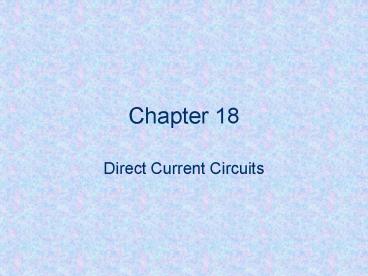Direct Current Circuits
1 / 18
Title: Direct Current Circuits
1
Chapter 18
- Direct Current Circuits
2
18.1 Sources of emf
- The source that maintains the constant current in
a circuit is called a source of emf. - Any device (such as batteries or generators)that
increase the potential energy of charges
circulating in circuits are sources of emf. - The device acts like a charge pump!
- The emf of a source is the work done per unit of
charge, the SI unit is the volt.
3
18.2 Resistors in Series
- Series circuit - only one path for the current.
- All charges must follow the same conducting path.
- The current in all resistors in a series circuit
are the same, because any charge that passes
through one resistor must also pass through the
other. - Figure 18.2
4
Series cont
- Regardless of how many resistors we have in
series, the sum of the potential differences
across the individual resistors is equal to the
potential difference across the combination. - This demonstrates conservation of energy.
5
Equivalent Resistance
- The equivalent resistance in a series circuit is
equal to the sum of all the individual resistors. - The equivalent resistance of a series combination
of resistors is always greater than any
individual resistance. - Any break in the circuit creates an open circuit,
thus the circuit is no longer complete. - Ex 18.1
6
Safety Measures
- In many circuits, fuses are used in series with
other circuit elements for safety purposes. - The conductor in the fuse is designed to melt and
open the circuit at some maximum current. - If a fuse were not used, excessive currents could
damage circuit elements, over heat wires, and
perhaps cause a fire. - Modern homes have circuit breakers instead of
fuses. - When the current in a circuit exceeds a certain
value (usually 15A), the breaker acts as a switch
and opens the circuit.
7
18.3 Resistors in Parallel
- A parallel circuit allows the current to travel
in more than one path. - When resistors are connected in parallel, the
potential differences across them are the same. - This must be true since the sides of the
resistors are connected to common points (Figure
18.4b). - The currents vary however, unless of course the
resistors are the same. - Remember charge follows the path of least
resistance!
8
Parallel cont
- Because charge is conserved, the current that
enters a junction, must equal the current
leaving the junction! - The potential drop across each resistor must be
the same for each resistor and must equal the
potential drop of the battery!
9
Parallel Equivalent Resistance
- The equivalent resistance of a parallel circuit
is defined as the reciprocal of the equivalent
resistance equals the sum of reciprocals for each
individual resistor. - The equivalent resistance of two or more
resistors connected in parallel is always less
than the smallest resistance in the group! - Ex 18.2
- Ex. 18.3
10
18.4 Kirchoffs Rules and Complex DC Circuits
- 1. The sum of the currents entering any junction
must equal the sum of the currents leaving that
junction( junction rule)! - (Conservation of charge)
- 2. The sum of the potential differences across
all the elements around any closed circuit loop
must be zero (loop rule)! - (Conservation of energy)
11
Kirchoffs Rules
- A real life example!
12
Kirchoffs rules
- 1. You must assign symbols and direction to the
currents in all branches of the circuit. If you
should happen to guess the wrong direction for
the current, the end result for that current will
be negative but its magnitude will be correct!
13
Kirchoffs rules
- 2. When applying the loop rule, you must choose a
direction (clockwise or counter clockwise) for
going around the loop. - As you traverse the loop, record voltage drops
and rises accordingly.
14
Summary of voltage drops and rises
- (a) If a resistor is traversed in the direction
of the current , the change in electric potential
is (-IR). - (b) If a resistor is traversed in the direction
opposite of the current , the change in electric
potential is (IR). - (c) If a source of emf is traversed in the
direction of the emf (from - to on the
terminals), the change in the electric potential
is E! - (d) If a source of emf is traversed in the
direction opposite of the emf (from to - on the
terminals), the change in the electric potential
is -E!
15
In General
- The numbers of times the junction rule can be
applied is one fewer than the number of junction
points in a circuit! - The loop rule can be applied as often as needed
so long as a new circuit element (resistor or
battery) or a new current appears in each new
equation! - You need as many independent equations as there
are unknowns!
16
Example Problems
- Ex. 18.4
- Ex. 18.5
17
Household circuits
- Utility company distributes electric power to
individual houses with a pair of wires or power
lines. - Electrical devices in a house are connected in
parallel to these lines (the potential drop
across these wires is about 120V)! - One wire is connected to the ground, and the
other (hot wire), has a potential of 120V. - A meter and circuit breaker (or fuse) are
connected in series with the wire entering the
house.
18
18.7 Safety
- A person can be electrocuted by touching a live
wire while in contact with the ground. - 5mA or less can cause a sensation of shock.
- Larger than 10mAcauses loss of muscle control.
- 100mA can be fatal.
- Special power outlets called ground fault
interrupters (gfi) are used in many new homes
that sense small amounts of currents leaking to
the ground. This device interrupts (shuts off)
the current.































